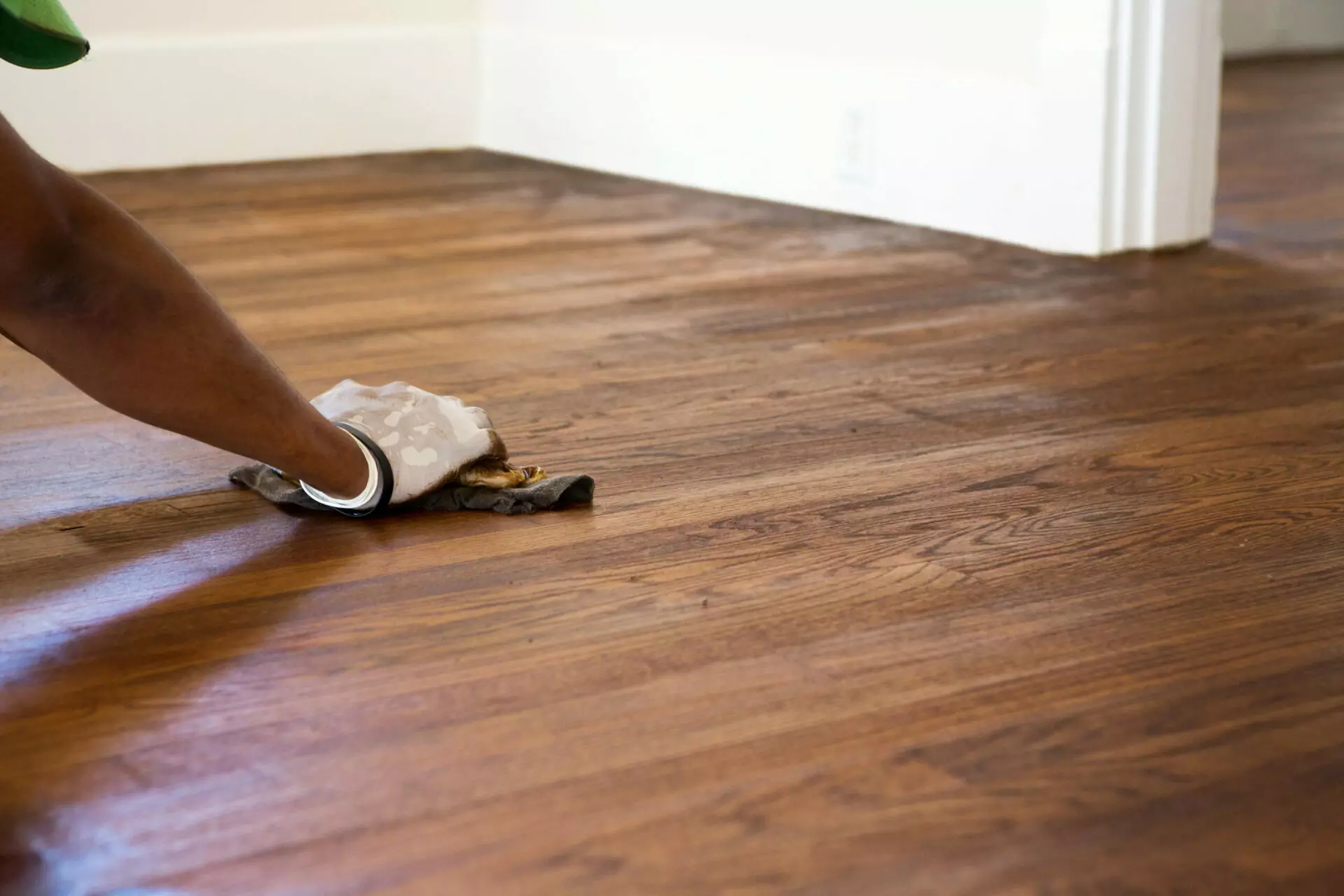To stain bamboo floors, sand to remove old finish and apply new finish for color and protection. Refinishing bamboo floors involves sanding and applying a new finish to enhance the material’s color and provide durability.
Staining bamboo floors can transform their appearance and extend their lifespan. With the right techniques, you can achieve the desired color and finish that suits your space. Properly maintaining and refinishing bamboo floors can enhance the overall aesthetics of your home while preserving the natural beauty of this sustainable material.
In this guide, we will explore the step-by-step process of staining and refinishing bamboo floors to help you achieve a beautiful and long-lasting result.
:max_bytes(150000):strip_icc()/cost-to-refinish-hardwood-floors-1314853-hero-e329de24b98e41ada4e9870699a6ca98.jpg)
Credit: www.thespruce.com
Understanding Staining Bamboo Floors
Staining bamboo floors can enhance their appearance and provide a protective finish. By sanding to remove the old finish and applying a new one, the color and natural beauty of the bamboo can be brought out. Bamboo floors can also be stained like wood after removing the old coating, resulting in a uniform finish.
Importance Of Refinishing
Refinishing bamboo floors is crucial to maintain their aesthetic appeal and durability. It helps to restore the natural beauty of the floors and protect them from wear and tear.
Comparison To Traditional Wood Floors
Staining bamboo floors can be likened to refinishing traditional wood floors. Both processes involve sanding the surface to remove imperfections and applying a new finish to enhance the appearance.

Credit: www.dustram.com
Choosing The Right Finish
Oil Sealers
- Easy application
- Simple touch-ups
- Enhances color and grain patterns
Can bamboo floors be sanded and refinished? Yes, bamboo floors can be sanded to remove old finish and refinished for a fresh look. One can easily change the color of bamboo flooring by applying a new finish after sanding. Staining bamboo floors is similar to staining wood floors, offering versatility in achieving desired aesthetics.
What is the best finish for bamboo floors? Opting for oil sealers is a popular choice due to their user-friendly application process and the ability to enhance the natural beauty of bamboo. Oil sealers penetrate the wood or bamboo, improving color depth and highlighting grain patterns. Additionally, spot touch-ups are hassle-free, ensuring long-lasting floor protection.
Can bamboo floors be bleached? While bamboo floors are sustainable and eco-friendly, it is important to avoid using harsh cleaners like oil or bleach, as these chemicals can damage the flooring finish. Following the manufacturer’s cleaning guidelines and using gentle, natural cleaners is recommended for maintaining the look and longevity of bamboo floors.
Can you sand and stain bamboo? Bamboo can be sanded and stained similar to traditional wood floors. Removal of the old finish or wax coating is essential before staining to ensure a uniform application. Sanding the bamboo surface allows the stain to penetrate effectively, providing a customized and refreshed appearance.
Should I test stain bamboo flooring? For strand-woven bamboo, testing a small area before staining the entire floor is advised. Vertical and horizontal bamboo types generally accept stain well, offering homeowners the opportunity to experiment with colors and finishes to achieve their desired look.
Refinishing Techniques
When it comes to refinishing bamboo floors, understanding the proper techniques is essential to achieving a professional and long-lasting finish. From sanding to staining, each step plays a crucial role in bringing out the natural beauty of bamboo while rejuvenating its appearance. Let’s delve into the intricacies of refinishing techniques, exploring the sanding and staining process, as well as the challenges associated with staining.
Sanding And Staining Process
Refinishing bamboo floors begins with the meticulous sanding process, which involves removing the old finish, dents, scratches, and worn areas to prepare the surface for staining. The sanding process necessitates precision and care to ensure a smooth and even surface, free from imperfections.
Once the sanding is complete, the staining process comes into play. Selecting the right stain is crucial in enhancing the natural color of bamboo and providing the desired visual appeal. The stain not only brings out the unique grain patterns but also offers protection to the bamboo flooring.
Challenges With Staining
- Unique Characteristics of Bamboo: The inherent composition of bamboo, with its dense fibers, can pose challenges in achieving uniform stain absorption, requiring careful application techniques.
- Stain Selection: Choosing the appropriate stain that complements the natural hues of bamboo while meeting aesthetic preferences can be a daunting task, often requiring meticulous testing and evaluation.
- Understanding the Finish: The final finish, whether matte, glossy, or satin, must be carefully considered to ensure it enhances the overall appearance and durability of the bamboo flooring.
Maintenance And Cleaning
Refinishing bamboo floors involves sanding to remove old finish, scratches, and dents, to apply a new protective color-enhancing finish. Bamboo floors can be easily sanded and stained similar to wood, with oil sealers being a recommended finish choice for its ease of application and enhancement of color and grain patterns.
Avoid harsh cleaners like oil or bleach to maintain bamboo flooring’s natural beauty.
Proper Cleaning Products
When it comes to maintaining and cleaning bamboo floors, using the right products is essential. Since bamboo is a natural material, it requires gentle cleaning products that won’t damage its finish or color. Here are some recommended cleaning products:
- Bona Hardwood Floor Cleaner: This cleaner is specifically formulated for hardwood and bamboo floors, offering a gentle and effective way to remove dirt and grime without leaving any residue.
- Naturally It’s Clean Floor Cleaner: Made with natural ingredients, this floor cleaner is safe for both bamboo and the environment, providing a non-toxic option for regular cleaning.
- Grove Co Multi-Purpose Cleaner: This all-purpose cleaner is versatile and can be used on a variety of surfaces, including bamboo floors. It’s free from harsh chemicals and leaves a fresh scent.
- Aunt Fannie’s Floor Cleaner Vinegar Wash: If you prefer a more natural and traditional approach to cleaning, this vinegar-based floor cleaner is a great choice. It effectively removes dirt and grime while leaving a streak-free finish.
Avoiding Harsh Chemicals
When cleaning bamboo floors, it’s important to avoid using harsh chemicals that can damage the finish and color. Harsh chemicals such as bleach and oil can strip away the protective coating of the bamboo and cause discoloration. Instead, opt for eco-friendly and gentle cleaning products that are specifically designed for bamboo floors.
Additionally, always follow the manufacturer’s guidelines for cleaning and maintenance to ensure the longevity of your bamboo floors. These guidelines may include recommendations for specific cleaning products and techniques that are safe to use on your particular type of bamboo flooring.
Common Issues And Solutions
To address staining on bamboo floors, consider sanding to remove old finish, scratches, and wear marks. Apply a new finish for color enhancement and added protection. Avoid harsh cleaners like bleach and opt for bamboo-friendly cleaning methods to maintain the floor’s appearance.
Uneven Absorption Of Stain
One common issue when staining bamboo floors is the uneven absorption of stain. Due to the natural variations and density of bamboo, it may absorb the stain unevenly, resulting in an inconsistent appearance. However, there are some solutions that can help you achieve a more uniform finish:
- Prepping the surface: Before staining, make sure to clean the bamboo surface thoroughly to remove any dust, dirt, or debris. This will help the stain penetrate more evenly.
- Applying a pre-stain conditioner: To promote more even absorption, you can use a pre-stain conditioner specifically designed for bamboo. This conditioner helps to open up the pores of the bamboo, allowing the stain to penetrate more evenly across the surface.
- Testing the stain: It is always recommended to test the stain on a small, inconspicuous area of the bamboo floor to see how it absorbs and dries. This will give you an idea of how many coats you may need to achieve the desired color and ensure a more uniform finish.
- Using thin coats: Instead of applying a single heavy coat of stain, it is better to apply multiple thin coats. This allows the stain to penetrate more evenly and reduces the chances of uneven absorbency.
- Buffing between coats: After applying each coat of stain, lightly buff the surface with a fine-grit sandpaper or a buffing pad to smooth out any uneven areas and promote better absorption of subsequent coats.
Floating Vs. Nailed/glued Installation
Another important consideration when staining bamboo floors is the type of installation method used. Whether you have chosen a floating installation or a nailed/glued installation, it can impact the staining process:
| Floating Installation | Nailed/Glued Installation |
|---|---|
|
|
By considering these factors and following the appropriate solutions, you can overcome common issues when staining bamboo floors, ensuring a beautiful and consistent end result.
:max_bytes(150000):strip_icc()/refinish-hardwood-flooring-1314864-hero-8c687ea6601148a2af507a47c0e57491.jpg)
Credit: www.thespruce.com
Frequently Asked Questions For Staining Bamboo Floors
How Do You Change The Color Of Bamboo Flooring?
To change the color of bamboo flooring, sand it to remove the old finish and apply a new finish for a fresh look and protection. Sealers like oil enhance the color and grain patterns. Staining bamboo is possible after sanding and removing the natural coating.
Avoid harsh cleaners and follow manufacturer guidelines.
What Is The Best Finish For Bamboo Floors?
The best finish for bamboo floors is an oil sealer. Oil sealers are easy to apply, allow for simple touch-ups, enhance the color and grain of the bamboo, and provide protection. You can sand the floor to remove the old finish and apply a new one to change the color.
Can You Sand And Stain Bamboo?
Yes, bamboo flooring can be sanded and stained like normal wood floors to remove old finish and enhance color. The new finish can be applied for protection. It’s recommended to follow flooring manufacturer’s guidelines.
Can Bamboo Floors Be Bleached?
Bleaching bamboo floors is not recommended as it can damage the finish. Instead, clean naturally and follow the flooring manufacturer’s guidelines.
Conclusion
As we conclude, staining bamboo floors is a great way to enhance their appearance and protect the material. With proper preparation and the right techniques, you can achieve beautiful results. Whether you’re considering a color change or just refreshing the existing finish, understanding the process and using the appropriate products are crucial for a successful outcome.
Happy staining!


